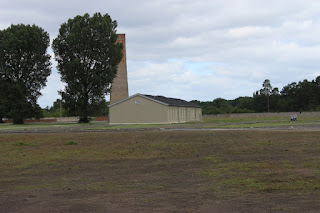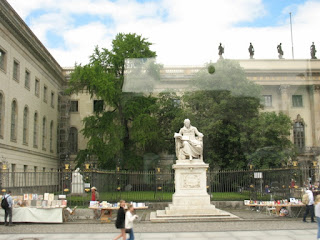 We docked around 6am in Warnemunde, Germany – a small port quite a ways from Berlin. You can’t travel this far and not visit Berlin itself, so we booked a Holland America transfer and spent a little over 3 hours on a bus to reach this legendary city. We had an excellent tour guide, though at times I was challenged taking notes. It was one of those days I wished I’d learned shorthand. So much to listen to and absorb.
We docked around 6am in Warnemunde, Germany – a small port quite a ways from Berlin. You can’t travel this far and not visit Berlin itself, so we booked a Holland America transfer and spent a little over 3 hours on a bus to reach this legendary city. We had an excellent tour guide, though at times I was challenged taking notes. It was one of those days I wished I’d learned shorthand. So much to listen to and absorb.
As most of you know, it’s the capital and largest city of Germany as well as one of its 16 constituent states. With a population of approximately 3.7 million, Berlin is the second most populous city proper and the seventh most populous urban area in the European Union. Located in northeastern Germany on the banks of the rivers Spree and Havel, it is the center of what’s known as the Berlin-Brandenburg Metropolitan Region, which has roughly 6 million residents from more than 180 nations. We thought we’d see a lot of concrete in the city, but were surprised to find that about one-third of the area is composed of forests, parks, gardens, rivers, canals and lakes. We learned that back in the 1920s, Berlin was the third largest municipality in the world. Then, after World War II and its subsequent occupation by the victorious countries, the city was divided; East Berlin was declared the capital of East Germany, while West Berlin became a de facto West German exclave, surrounded by the Berlin Wall (1961–1989) and East German territory. Following German reunification in 1990, Berlin once again became the capital of all-Germany.
Considering the amount of damage to the city during WW2, we were pleasantly surprised to see that the city has recovered very nicely. In fact, Berlin is a world city of culture, politics, media and science. Its economy is based on high-tech firms and the service sector, encompassing a diverse range of creative industries, research facilities, media corporations and convention venues. Berlin serves as a continental hub for air and rail traffic and has a highly complex public transportation network. Significant industries also include IT, pharmaceuticals, biomedical engineering, clean tech, biotechnology, construction and electronics. Modern Berlin is home to world renowned universities, orchestras, museums, entertainment venues and is host to many sporting events. Its urban setting has made it a sought-after location for international film productions. The city is well known for its festivals, diverse architecture, nightlife, contemporary arts and a high quality of living. Since the 2000s Berlin has seen the emergence of a cosmopolitan entrepreneurial scene.
On the downside, in 1933 Adolf Hitler and the Nazi Party came to power. NSDAP rule diminished Berlin's Jewish community from 160,000 (one-third of all Jews in the country) to about 80,000 as a result of emigration between 1933 and 1939. After Kristallnacht in 1938, thousands of the city's Jews were imprisoned in the nearby Sachsenhausen concentration camp. It’s located in Oranienburg, about 20 miles north of Berlin. It’s there where you see the hospital rooms, Station Z where the executions took place, the former barracks, where a museum tells its grizzly story, and the former laundry, now a chapel. That’s where we spent several hours. It was a heartrending, very moving experience. Sachsenhausen wasn’t merely a working camp, as several thousand were executed there. Of the dozens of barracks originally constructed to house the prisoners, only one remains today. We were able to walk through and observe these cramped quarters which, according to our local guide, held up to 450 prisoners. It was no longer than perhaps 50’X25’ – absolutely deplorable. Station Z was so named because the letter Z represents the last letter of the alphabet – the end of the line. It remains intact today, and still very much resembles the original photos from the 1940’s. It was there that prisoners were executed…usually a shot in the head…then loaded on a cart and taken a few feet to the crematorium, which also still exists. This was very emotional for both of us. One struggles to imagine the massive pain & suffering here. Starting in early 1943, those not executed at Sachsenhausen were shipped to death camps, such as Auschwitz. During World War II, large parts of Berlin were destroyed in the 1943–45 air raids and during the Battle of Berlin. Around 125,000 civilians were killed. After the end of the war in Europe in May 1945, Berlin received large numbers of refugees from the Eastern provinces. The victorious powers divided the city into four sectors, analogous to the occupation zones into which Germany was divided. The sectors of the Western Allies (the United States, the United Kingdom and France) formed West Berlin, while the Soviet sector formed East Berlin. The Berlin Wall (painted on the western side) was a barrier that divided the city from 1961 to 1989.
All four Allies shared administrative responsibilities for Berlin. However, in 1948, when the Western Allies extended the currency reform in the Western zones of Germany to the three western sectors of Berlin, the Soviet Union imposed a blockade on the access routes to and from West Berlin, which lay entirely inside Soviet-controlled territory. The Berlin airlift, conducted by the three western Allies, overcame this blockade by supplying food and other supplies to the city from June 1948 to May 1949. In 1949 the Federal Republic of Germany was founded in West Germany and eventually included all of the American, British and French zones, excluding those three countries' zones in Berlin, while the Marxist-Leninist German Democratic Republic was proclaimed in East Germany. West Berlin officially remained an occupied city, but it politically was aligned with the Federal Republic of Germany despite West Berlin's geographic isolation. Airline service to West Berlin was granted only to American, British and French airlines.
The founding of the two German states increased Cold War tensions. West Berlin was surrounded by East German territory, and East Germany proclaimed the Eastern part as its capital, a move that was not recognized by the western powers. East Berlin included most of the historic center of the city. The West German government established itself in Bonn. In 1961 East Germany began the building of the Berlin Wall between East and West Berlin, and events escalated to a tank standoff at Checkpoint Charlie. We have a few photos below of this particular site. West Berlin was now de facto a part of West Germany with a unique legal status, while East Berlin was de facto a part of East Germany. John F. Kennedy gave his "Ich bin ein Berliner" – speech in 1963 underlining the US support for the Western part of the city. Berlin was completely divided. Although it was possible for Westerners to pass from one to the other side through strictly controlled checkpoints, for most Easterners travel to West Berlin or West Germany was prohibited by the government of East Germany. In 1971, a Four-Power agreement guaranteed access to and from West Berlin by car or train through East Germany.
In 1989, with the end of the Cold War and pressure from the East German population, the Berlin Wall fell on November 9th and was subsequently mostly demolished. Today, the East Side Gallery preserves a large portion of the wall…a good city-block long. We were able to stop and snap photos of this landmark as well. In October 1990, the two parts of Germany were reunified as the Federal Republic of Germany and Berlin again became the official German capital. In 1991, the German Parliament, the Bundestag, voted to move the seat of the German capital from Bonn to Berlin, which was completed in 1999. In 1994 soldiers from the United States, France and Britain marched in a parade which was part of the ceremonies to mark the final withdrawal of foreign troops allowing a reunified Berlin. Berlin's 2001 administrative reform merged several districts. The number of boroughs was reduced from 23 to 12. In 2006, the FIFA World Cup Final was held in Berlin.
We were extremely impressed with not only Berlin, but the port city of Warnemunde and all the small communities in route to Berlin were very nice, very clean, and very friendly. The long drive from the port reminded us of South Carolina & Wisconsin – rolling hills, cattle grazing, very green, and lots of agriculture – primarily corn, wheat, & barley. And the Audubon…unbelievable! The speed limit on buses and large semi’s is 62mph. Beyond that, there are no laws. We had cars & vans whizzing past us going at least 120mph…some faster! In some cases, our bus actually shook as were being passed. I’ve never experienced anything like that in my life!
A truly memorable day, with wide emotional swings. Extremely educational.










































































































































































1 comment:
I think the funniest thing is there is a McDonald's right next to Checkpoint Charlie. Great pictures brings back our memories of Berlin from 7 years ago. So happy you are having a wonderful time.
Post a Comment